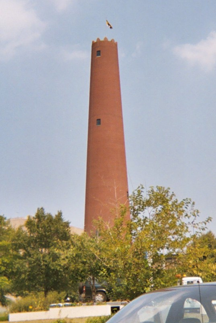
Photo by Bruce Andersen
This is the first of a series of posts about Baltimore landmarks and locations.
The Phoenix Shot Tower
I grew up knowing the tower simply as the old Baltimore shot tower. It’s a red brick tower, 234 feet tall located in East Baltimore, nearby to Little Italy and Jonestown. It was the tallest structure in the United States when it was completed in 1828. The cornerstone was laid by Charles Carroll of Carrollton, the last surviving signer of the Declaration of Independence.
The tower was used to manufacture both drop shot—for use in pistols and rifles—and moulded shot for cannons. Molten lead was poured through a sieve at the top of the tower into a vat of cold water at the bottom of the tower to produce the drop shot. After it hardened, it was dried, polished and sorted into 25 pound bags. The tower produced 100,000 bags annually, and was capable of doubling that output if necessary. It stayed in production until 1892 when this method of producing shot became obsolete.
It remained the tallest structure in the US until 1846, when Trinity Church was erected in New York on Wall Street. It remained the tallest in Baltimore until 1875, when the spire of the First Presbyterian Church (on West Madison and Park Avenue) was completed. Still, from the top, the view of the city—and beyond—is unobstructed.
The tower is one of four that used to stand in Baltimore, and was very nearly destroyed in 1924 by the Union Oil Company. They’d purchased the land, and wanted to erect a gas station. City residents objected and raised enough money to buy back the land and present it to the City of Baltimore. It became a National Historic Landmark in 1971.
The tower is open limited hours on the weekends, though visitors haven’t been able to go to the top since about 1997, due to the safety of the staircase. This is soon to change, however! The city has designated $240,000 to fix the staircase, and estimates visitors will once again be able to walk to the top (all 305 steps) as early as mid-2017.
Although the tower is one of my favorite places in Baltimore, it’s not a prominent location in the Charm City Darkness novels. But the tower is the main location in one of my Charm City Darkness short stories—called Giving a Hand—in which Assumpta helps the tower’s resident ghost. Giving a Hand has been published in the Hides the Dark Tower Anthology, and will be available as a single later this year.